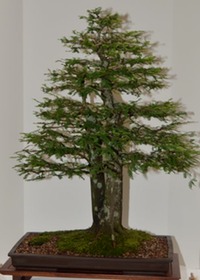What to Consider When Choosing Bonsai Material
You will probably be searching for bonsai stock in nurseries that do not specialize in bonsai material. Unfortunately in the Florida Panhandle there are no bonsai nurseries. That leaves the landscape nurseries for you to conduct your search. Don’t overlook what is in your own yard or that of a friend.
Species that do well in our area as bonsai are also species that are used in our urban landscapes. Concentrate your search on elms, pines, azaleas, boxwoods, cypress, juniper, maples, dwarf yaupon (holly) and Japanese black pine. There are other species that do well but these are the most commonly available.
It is possible to grow your bonsai from cuttings and seed, but they are slow processes. Searching for suitable material for bonsai can be an exciting hunt but you have to remain flexible and be patient. Look for plants that are healthy, with no evidence of insect damage. Color should be good; fresh green usually indicates a healthy plant.
The trunk of any bonsai tree is the most difficult element to change in a short time. A typical trunk flares at the base above the root mass and can have some exposed roots on the surface of the soil.
Now start looking at the trunks of your chosen plant. Several plants in a single pot are found quite often in nursery stock. It is the industry standard to place two to four plants in one pot to increase the likelihood that at least two will survive. Unless the plants have been grown together for some time and have grafted (joined) together, they are still single trunk plants
Multiple trunk bonsai make wonderful specimens; those trunks originate from one root mass and have a single base. Good bonsai can be developed from a plant with multiple trunks if that is the style you want, otherwise keep searching for a single trunk.
Another fact of working with landscape plant material is the way plants are “up-potted” or moved to larger and larger pots over time. Each time a plant is repotted there is the potential for additional soil being piled around the trunk above the main roots. Sometimes there is a lovely spreading root system buried some inches down. The real roots of the tree may be several inches below the soil line so it is a good practice to carefully dig around the base of a nursery tree to discover just how deep the tree is planted. Take a chop stick with you to gently move the soil away from the trunk so you can judge. Don’t be bashful about hunting for good stock but take care to not harm the plants you examine.
Once you find some single trunk plants, notice if the plant has developed some girth or size on the trunk. The trunk should taper from the soil line to the first branch and continue to taper up through the height of the tree. Larger nursery plants can be cut off and shaped to give taper to the trunk and leave you with a tree that looks older than it actually is.
Low branches close to the soil level can help increase trunk size. Remember that a one inch trunk diameter will look much larger on a six to ten inch bonsai than a one inch trunk diameter appears on a much taller tree. Some tall and leggy plants make impressive bunjin bonsai. If you know what you want, keep your options open.

So you find a plant that has a nice trunk for its size. Now look at the way the branches grow from the trunk. It is always good to have choices between branches when designing any bonsai. Are they all on one side? Is the thickest branch at the top of the tree while near the soil the branches are thin or weak or spindly? Good bonsai material has larger branches lower on the trunk which graduate to finer branches near the apex of the tree.
Some of the best bonsai material is found as stunted old trees in the woods or in landscape beds. Look for “old growth” plants. These are hard to find in nurseries due to normal plant rotation. Always have permission to take material that is not on your own property.
The reality of working with live plant material is there are no perfect plants. That is where the art of bonsai comes forward. The ability to make a silk purse from a sow’s ear is often second nature to some bonsai artists but it takes time to develop that ability. Beginners are better off working with the best material available and leaving the sow’s ears to the sow.